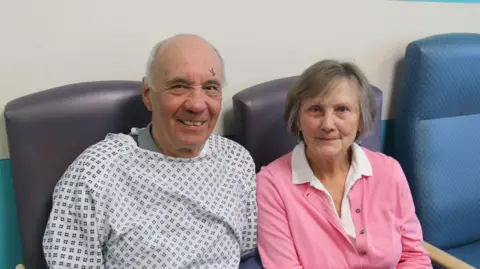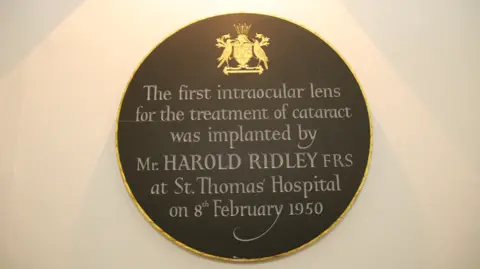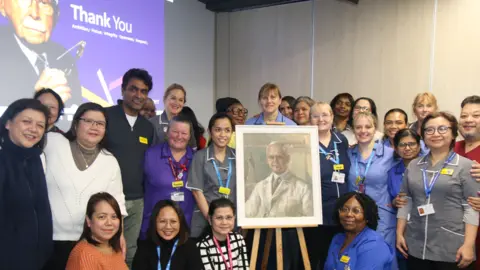Couple help NHS mark 75 years of cataract surgery
 Guy’s and St Thomas’ NHS Foundation Trust
Guy’s and St Thomas’ NHS Foundation TrustThe NHS is celebrating 75 years of cataract surgery, an operation which helps restore vision.
The operation involves removing a lens - a small transparent disc inside the eye - that has become cloudy and replacing it with one made out of acrylic plastic.
Without the operation, the cloudy vision can lead to blurry vision and eventually blindness. Roughly half of those over the age of 60 have some degree of cataracts.
Since it was first offered at St Thomas' Hospital in 1950, nearly one billion cataract surgeries are estimated to have taken place across the world.
One couple from south-east London who have undertaken the procedure is John and Freda McBean.
"I am already feeling better and can see more brightness than I could see before," said Mr McBean, a retired deputy teacher from Chislehurst.
About 10 years ago, he tore his retina and during the procedure to fix it, the surgeon noticed a cataract was starting to form.
Over the last five years, Mr McBean's vision deteriorated leading him to have cataract surgery on his left eye in February to remove the cloudy lens.
He said he was not nervous as his wife had the operation on both eyes last year.
 Guy’s and St Thomas’ NHS Foundation Trust
Guy’s and St Thomas’ NHS Foundation TrustMrs McBean, 72, said her vision was now excellent, and that she only needed reading glasses for very fine print.
The retired primary school teacher said: "The surgery went beautifully and the experience was unbelievable."
Speaking of his own procedure, Mr McBean said: "I couldn't believe it when I was told I was one of the patients getting surgery around the anniversary.
"I feel like I know the surgery so I wasn't nervous."
He added: "It was amazing and I am absolutely in awe of the team.
"It's amazing that over the course of my lifetime this operation has been finessed, and it's nice to be a part of the history of the hospital."
 Guy’s and St Thomas’ NHS Foundation Trust
Guy’s and St Thomas’ NHS Foundation TrustSir Harold, the creator of the procedure, made his medical breakthrough after treating a Spitfire pilot who had splinters of acrylic in his eye.
He noticed that unlike most other foreign material, the eye did not reject this type of plastic.
At the time, Sir Harold's invention was considered radical and was initially resisted by much of the medical profession - but over time it has become the most common eye operation in the world.
Today, the surgery takes only 15 to 30 minutes per eye, and patients are discharged within hours.
To celebrate 75 years since its invention, ophthalmologists at Guy's and St Thomas' unveiled a portrait of Sir Harold Ridley gifted to the hospital by the Ridley Eye Foundation.
Dr Sancy Low, the consultant ophthalmic surgeon who performed Mr McBean's surgery, said: "The story of Sir Harold Ridley's journey is an incredible reminder of how we can bring light to the world, changing the lives of John, Freda and millions worldwide."
Listen to the best of BBC Radio London on Sounds and follow BBC London on Facebook, X and Instagram. Send your story ideas to [email protected]
